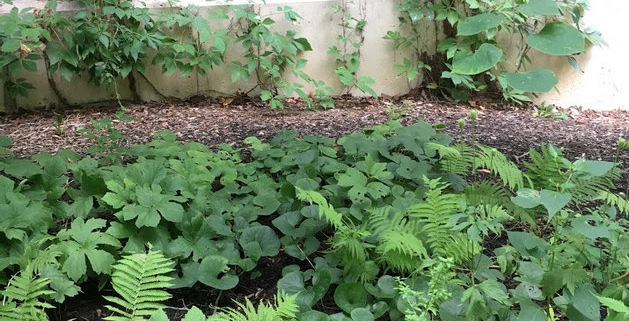Beat the summer heat with a native plant shade garden
Photo by Plant NOVA Natives
They say shade gardens are the gardens of the future, since it will be too hot to spend much time in the sun. That’s pretty much the case already on most summer days. Although sunny butterfly gardens still provide hours of entertainment, a shady place to relax or play in your yard is a welcome addition. An added bonus is that gardening is a lot easier in the shade, because the weeds grow much more slowly.
There are plenty of native flowers available to provide color in a shade garden. You can see examples of them on the shade garden page of the Plant NOVA Natives website. Many of those species also make excellent ground covers. For example, Woodland Phlox and Golden Ragwort are evergreen and spread to make a mat, with blue and yellow flowers respectively in the spring. April and May are a particularly lively time in the shade, as spring ephemerals such as Virginia Bluebell and Spring Beauty pop up and bloom before the trees and shrubs leaf out, then disappear when the shade gets too heavy. They make perfect companion plants for the ferns and sedges that provide a cooling backdrop all summer long. Contrasting foliage textures create visual interest even without flowers.
Why choose native plants? A plant is native to our environment if it evolved within the local food web and has the intricate relationship with animals and other plants that this implies. Plants such as turf grass and many of the ornamentals that were brought here after the arrival of the Europeans are nearly useless (and sometimes actually harmful) from an ecosystem perspective. Choosing native plants allows us to fit into the ecosystem instead of displacing it.
Most native plants can be planted any time of year that the ground is not frozen or saturated. Spring is of course the most popular time for gardening (though fall is even better.) As consumer interest has grown, conventional garden centers have been providing an ever-increasing variety of native plants. In Northern Virginia, 22 garden centers have red stickers on their native plants, placed there by Plant NOVA Natives volunteers, so all you have to do is walk down the aisles and look for the stickers. In addition, several local garden centers sell only native plants, which gives you the best selection of all.
In some cases, the first step toward creating a shade garden will be to create the shade. A glaring hot lawn is uninviting and can be remedied by simply planting native trees. Since most trees require full sun to grow, an empty lawn is the perfect location for a grove of trees that will beautify your property while reducing air conditioning costs. Underplanting the trees with shrubs will provide homes and food for the birds.




